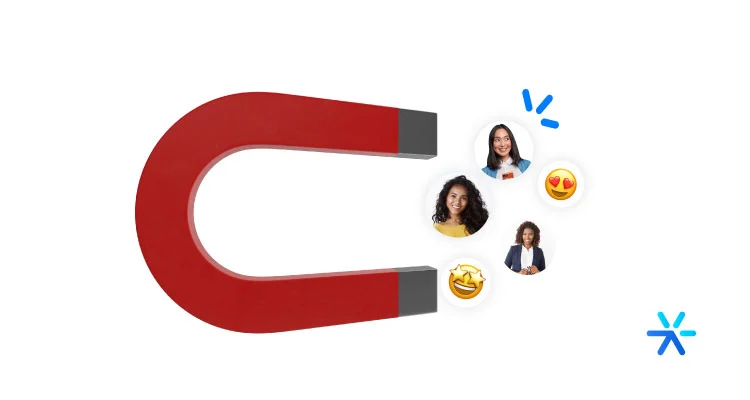What is Service Marketing and How to Succeed
What exactly is service marketing? How does it differ from other types of marketing?
These are the questions that everyone working in service companies asks at some point.
And in many cases, it is difficult to find the answer. Service marketing is very similar to other types of marketing today because it pioneered Inbound Marketing, the largest marketing methodology in the contemporary world.
There are some significant particularities when we talk about service marketing. But at the same time, these particularities have been so well developed over the years that there is already a whole systematization in the way of creating campaigns and generating sales.
Today we are going to discuss all aspects of service marketing in this article: how it connects with Inbound Marketing, how it works with paid media, how it generates leads, and how it makes sales.
But first, it is very worthwhile to better understand where the main precepts of service marketing today come from.
Service Marketing and Inbound Marketing

Was service marketing responsible for the emergence of Inbound Marketing in the world?
More or less. The term Inbound Marketing itself was created by Dharmesh Shah and Brian Halligan, the founders of HubSpot.
HubSpot is a SaaS company, which means it sells software as a service.
Basically, SaaS companies combine a sales strategy focused on a product with support and customer service that is very similar to that offered by service companies.
It’s a mix that worked very well for the tech scene. In the case of HubSpot, the product is sold online, but from the moment you buy it, you receive support characteristic of the service sector.
In this scenario, Inbound Marketing emerged: the methodology combined the complexity of service sales with the facilities of digital marketing, thus creating a bridge between the difficult and the easy.
But since we are talking about the specific needs that service marketing brings, how about we expand this topic a little more?
First, let’s understand what are the main particularities of the service sales process.
And then we will understand how marketing, especially Inbound Marketing, works to solve them — and even monetize them.
The main challenges of service marketing

Service marketing carries some challenges that have existed for decades.
We need to understand that what we are discussing here has actually been happening for a long time. Service companies have existed since the world began.
In fact, the first complaint in the world happened in 1750 BC when Ea Nasir, a Mesopotamian merchant, sold copper ingots to Nanni, a blacksmith who did not like the quality of the service and sent a complaint by cuneiform tablet.
Since the 19th century, with the advent of modern advertising, the service sector has been understanding its limitations and seeking ways to overcome them.
We have an article here on the blog that brings the best marketing books that talk about this subject and some others as well. It’s worth reading after this article!
But for now, let’s better understand what the main challenges of service marketing are. Right after, let’s understand how to overcome them.
Ready?
Demand generation
The fundamental basis of service marketing is demand generation, especially when it comes to localized and regional services.
These, not by chance, correspond to the largest share of active companies in Brazil today, according to IBGE.
The point is that many service companies, if not all, are “trapped”: they offer a service according to demand. For each successfully performed service, the demand for it decreases.
For example: an air conditioning installation company. For each installed air conditioner, there is one less to be installed in the city.
It’s different from a clothing store, for example: those who buy one, buy two, three, four blouses 😅
Because of this, service companies realized very early on that it is necessary to generate demand. The air installation requires periodic maintenance. The uninstallation needs to be done by professionals. And so on.
Customer loyalty
Another challenge in service marketing is customer loyalty, which becomes more complicated when services do not need to be repeated frequently.
This is the case with air conditioning, for example. The first maintenance after installation will happen a year later. And uninstallation doesn’t even have a date.
Customer loyalty in service marketing, of course, will also depend on the complexity of the service offered.
Just as it is complicated for air conditioning installation, it is simpler for other companies, such as a mechanical workshop, for example.
However, the preference here is for the service provided, not for a brand. And the service provided is very difficult to standardize, unlike a simple product.
Still in the example of the mechanical workshop: you can guarantee 9 great services out of 10. But that 1 can happen at any time and make you lose customers.
At the same time, if you buy 10 boxes of BIS chocolate, it is very likely that all of them will have the same flavor, the same packaging, and offer the same experience.
Customer loyalty in the service sector, therefore, is much more complicated to achieve.
Finding new markets
Another difficulty in service marketing is finding new markets for the solutions being developed.
This is very common in companies that have spent years providing the same services but end up facing demand limitations.
Suddenly, the company that has been operating the same way for a long time is pressured to develop new solutions and approach a completely new market.
But look: this is a blessing and a curse at the same time.
While service companies can develop these new services without large expenses — retail needs to invest in creating new products, for example — entering this new market is very difficult.
In fact, finding it is the first difficulty. Then, it is necessary to understand how the competition is already operating. And finally, develop marketing strategies.
All this takes time and requires investments. And it may be that the new service does not have the initial traction expected.
Developing new services
The very development of new services is also a challenge for service companies.
Often, the initial development of the company’s services involves people who were already doing this work before.
For example: someone who worked in marketing for 20 years deciding to open an agency. Or the case of air conditioning — the person spends years installing and decides to open their own company.
The development of new services when the company is already operating requires some steps that are quite difficult to take.
It is necessary to find new specialists, present the idea, think about how the service will be performed, identify new markets, launch it, collect feedback, and work on demand generation.
All this takes time and investment. So, is it worth investing in the new or continuing to allocate resources to what is already successful?
Keeping up with changes in the target audience
Nowadays, everything changes very quickly.
Look, for example, at the case of HubSpot. When it started its demand generation work, few people knew what Inbound Marketing was.
That is: educating the target audience was much easier because the concept was completely new.
But from the moment HubSpot opened this door, everything changed: several agencies began to emerge and follow all the strategies that HubSpot determined.
And several other products/services also emerged in the competition. Within a year or two, the audience that was starting to learn about Inbound became very well informed by many others.
This is happening with all service sectors today. The target audience changes a lot because marketing is pushing companies to levels they never imagined possible.
For every service, there is an app. Now, everyone is served via WhatsApp. There are blogs for practically all imaginable sectors.
You will be dealing with a customer who informs themselves a lot about your services before they even know you.
Marketing departments today need to take this into account: all the tips we will see together here on the blog have already been followed by other service companies for a long time.
The target audience has changed and continues to change.
How to Succeed in Service Marketing?
As we have seen, working on service marketing is a complex task.
But this complexity is actually more about the amount of work to be done and the various marketing tools that need to be implemented.
The reality is that there are two main methodologies you need to understand in digital marketing for services: Inbound Marketing and, within Outbound Marketing, paid media.
The issue is that these two methodologies are large umbrellas composed of smaller methods that need to be applied for everything to work out.
Let’s discuss these two methodologies now and also bring more articles that delve into each of the methods needed for their application.
Inbound Marketing for Services
Inbound Marketing is a very fundamental strategy for service marketing.
As we saw at the beginning of the article, one of the most critical points in service marketing today is demand generation.
Demand generation is one of the most fundamental aspects of Inbound Marketing, which works with content marketing precisely to address this need.
Below, I have listed the most common methods and tools in Inbound Marketing for services. Keep reading:
Content for Demand Generation
Demand generation is a very sensitive job that takes quite some time to execute.
Mainly because its primary operation is through Content Marketing.
Basically, companies that bet on this method are looking to identify the problems that their service solves in the lives of their target audience.
And these problems, once identified, are first addressed through content, which will eventually lead to sales by moving through the Marketing and Sales Funnel.
A quick example: you work with pool maintenance. Demand generation happens when you determine the main problems that pools present and how to solve them.
It also works in launching new products, educating the market on a need they may not have known existed.
For example, those who invented the ozone tablet had to do demand generation work to teach the market that it is no longer necessary to add pure chlorine to the pool.
All of this is done through content, which can take various forms: social media posts, articles on the blog, more in-depth e-books, YouTube videos, webinars, live streams, and so on.
Lead Generation
With the audience being educated, it is necessary to generate qualified leads from the people consuming your content.
This is not difficult at all. You can, for example, install a chatbot on your site and automate the qualification of your visitors.
With chatbots, it is also possible to deliver more materials to visitors, encouraging conversion.
The truth is that lead generation works through offers and Calls to Action (CTAs).
Once your audience is well educated, you start offering offers according to their stage in the Funnel.
Some examples:
- Top of the Funnel: e-books, whitepapers, webinars, newsletters, etc.;
- Middle of the Funnel: market benchmarks, product catalogs, etc.;
- Bottom of the Funnel: discount coupons, commercial presentations, etc.
To access these materials, an email is required. Once the visitor downloads it, they enter your company’s lead base.
Important: you will receive visitors at any of these stages. And each of them has specific actions you need to follow.
Learn more about each one by clicking on the links. But considering someone arriving at the Top of the Funnel, it is necessary to perform lead nurturing.
More on that now:
Lead Nurturing
Lead nurturing is another fundamental aspect of service marketing.
Considering the person who has just entered the Funnel, it is necessary to create nurturing flows that will take them through all the stages until the final phase, the sale.
This nurturing flow starts by offering more content, more material, so that the person understands everything related to the product and their needs.
Over the next stages, a more commercial approach is applied until reaching the Bottom, where contact is usually direct with salespeople.
This work is usually done via email, especially when applied in B2B Marketing.
But in the case of retail, it is spread across various types of content, including unboxing, reviews by influencers, WhatsApp messages, and so on.
We have an article that expands more on lead nurturing here on the blog. It is essential for service marketing.
Organization in Sales CRM
Everything we are discussing here is done through two main systems: an Inbound Marketing platform and a sales CRM.
The CRM, in this case, works to coordinate the efforts of the sales team with the marketing team, but it is more focused on sales.
It is through the CRM that leads will reach the salespeople, and it is also through the CRM that salespeople can organize information related to the progress of the sale.
Marketing platforms have a different purpose: they organize your efforts in lead generation and nurturing, allowing you to create forms, send emails, and manage the lead list.
Final Contact for Closing the Sale
The final step for Inbound applied to service marketing is contacting the hot leads generated by marketing.
The classification of leads follows these parameters:
- MQL: lead qualified by marketing and ready to be approached by the sales team;
- SAL: lead approved by the sales team as qualified. The qualification process by the salespeople begins from here;
- SQL: lead qualified by the sales team, ready to receive a formal proposal;
- PQL: for SaaS companies, these are leads who have already tried the product;
There are other terminologies, but these are enough for us to understand the general classification.
Once leads reach the necessary maturity, salespeople need to contact them.
However, the way this contact happens varies greatly. Some brands contact by phone. Others send personalized emails. There are those with so much demand that even this contact is automated.
In any case, this is the most crucial part of the job. It needs to be done with great care and dedication, as it justifies all the work done so far.
Outbound Marketing for Services
Outbound Marketing is also a great ally for the services sector, especially in paid media, but not only in that.
Service marketing, due to its often limited nature regarding sales — as we discussed about demand generation — needs to constantly expand its reach.
Inbound Marketing solves this problem, but not immediately. In fact, it is known for being a long-term effort.
Outbound Marketing is the solution many companies find to generate revenue and ensure the expansion of their services in the region.
It only comes with one small problem: its costs are higher and also immediate.
The two main ways to work Outbound in Service Marketing are as follows:
Paid Media
Here, Google Ads and Meta Ads stand out.
These two platforms can guarantee excellent short-term results for service marketing.
The only caveat is the costs. And another, related to costs, is what happens when you stop paying.
Google Ads requires investment, both in the campaigns you run and in hiring specialist professionals. The same goes for Meta Ads.
And when you stop paying, all the results you were getting with paid media simply cease to exist.
This is the fundamental counterpoint of Paid Media, which Inbound solves but in the long term.
ABM
Account-Based Marketing is another advanced Outbound strategy.
Basically, ABM proposes Outbound (and some Inbound) approaches to target the best lead profiles for sales.
These are very advanced profiles, going far beyond creating a broad target audience, for example.
Usually, the lead list made with ABM is quite small. At the regional level, it can have even fewer than ten leads, but all extremely qualified.
Telemarketing
Surprisingly, we are experiencing a telemarketing renaissance. Think: how many times, just today, have you received calls from a company?
Service companies are heavily investing in telemarketing, but the implementation model is lacking.
It is possible to do ethical telemarketing: good salespeople with a good lead list can make calls that do not disturb anyone; on the contrary, they even help.
But the main task here is finding a good list of qualified leads. That’s why phone approaches usually happen as an arm of the Inbound Marketing strategy.
So, do you have any questions about how service marketing works?
This work is quite interesting to do, and what I am telling you here are not assumptions: I have gone through this path several times, primarily working in service companies.
Here at Leadster, we are also a service company. We are SaaS, offering our software not as a product but as a service as well.
Sign up today!







